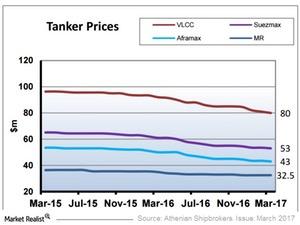What Current Tanker Prices Tell Us about the Tanker Industry
Newbuild vessel prices fell in March 2017. We saw in our last month’s series that newbuild vessel prices also fell in February.
April 28 2017, Updated 6:06 p.m. ET

Newbuild vessel prices
Newbuild vessel prices fell in March 2017. We saw in our last month’s series that newbuild vessel prices also fell in February. For the past several months, newbuild vessel prices have been on a downward trend. VLCC (very large crude carrier) newbuild prices fell 12.0% in 2016, and Suezmax prices fell 15.0%. So far in 2017, VLCC newbuild prices have already fallen 5.0%, and Suezmax prices have fallen 2.7% compared to the start of the year.
According to data from Athenian Shipbrokers for March, newbuild prices were as follows:
- $81.0 million for VLCCs compared to $81.0 million in February
- $53.0 million for Suezmax compared to $53.5 million in February
- $43.0 million for Aframax compared to $43.5 million in February
Newbuild vessel values signify the expectations of freight rates going forward. Demand for newbuild tankers is falling, and companies aren’t ordering new vessels, so there’s been a fall in vessel prices.
Secondhand prices
Five- and ten-year VLCC values for March 2017 were $62.0 million and $42.0 million, respectively. Prices have remained constant since January. Suezmax and Aframax secondhand prices have also been constant since January.
Time premium
Time premium is calculated as the ratio of secondhand tanker values to the current newbuild price. We’ve taken the five-year vessel value as a proxy for secondhand prices. Assuming that a vessel’s life is 25 years, a five-year vessel would be worth 80.0% of the newbuild price.
If an industry participant has a positive outlook on the crude tanker industry in the short to medium term, it will pay a premium on secondhand vessels to obtain ships immediately. In contrast, if the outlook is negative, assets will be valued lower.
In March, the ratio rose slightly from 756.5% in February to 77.5%, but it’s still below 80.0%. The ratio fell compared to its level of 86.0% at the start of 2016. Freight rates have fallen steeply, with falling oil production and the tanker supply glut among the reasons why tanker owners aren’t ready to pay premiums for secondhand tankers.
The above situation indicates a bleak short-term outlook for companies such as Frontline (FRO), Nordic American Tankers (NAT), Teekay Tankers (TNK), Euronav (EURN), DHT Holdings (DHT), and Tsakos Energy Navigation (TNP).
Investors who are interested in broad exposure to industrial stocks can invest in the SPDR Dow Jones Industrial Average ETF (DIA).
